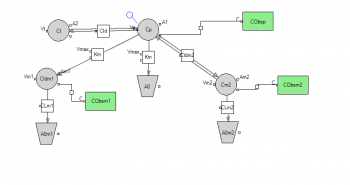Bruno,
I mean rewriting the model using PML. But note that since you can convert both library and graphical models to PML this is generally pretty easy to do. In your case, if I understand your model correctly, after converting the appropriate closest library model you only need to add/modify the couple of statements I mentioned in my email.
Dan W
Dan,
Thank you for your continuing explanations. I have tried unsuccessfully to re-write my model in PML. I copy the code below. The model runs, but does not estimate anything. Is there something obviously wrong? Should there be an "else" statement after the "if" statement? If so, how should it be written (from the PML documentation, it looks like it should be [else {dosepoint(A1, rate=0)}], but this is not recognized by the program)? Also, can tinf (infusion time) be entered as a fixed effect, or does it mean that it would be estimated by the model? The reason I did it this way is that I have 6 subjects and 3 infusion times (2 subjects for each), and would like to run the model in population mode; the fixed effect statement allows me to enter a value for each subject as an initial estimate. I have tried to run the same model for a single subject, specifying the value of tinf in the model, but it still does not estimate anything. I have also tried to enter the initial estimates in the fixed effect statements, which again, does not solve my problem.
Bruno
test(){
target=7.6
Vi=126.7
k10=0.2091
k12=0.3298
k13=0.01462
k21=0.1334
k31=0.0071415
deriv(A1 = - Cl * C - Cl2 * (C - C2) - Cl3 * (C - C3))
deriv(A2 = Cl2 * (C - C2))
deriv(A3 = Cl3 * (C - C3))
if (t<=tinf) {dosepoint(A1, rate=TCI)}
TCI=target*Vi*(k10+k12*exp(-k21*t)+k13*exp(-k31*t))
C = A1 / V
C2 = A2 / V2
C3 = A3 / V3
error(CEps = 1)
observe(CObs = C + CEps)
fixef(V)
fixef(V2)
fixef(V3)
fixef(Cl)
fixef(Cl2)
fixef(Cl3)
fixef (tinf)
}
 Metabolite_Kinetics_PK19.txt 741bytes
1388 downloads
Metabolite_Kinetics_PK19.txt 741bytes
1388 downloads Metabolite_Kinetics_Webinar.pdf 743.17KB
2447 downloads
Metabolite_Kinetics_Webinar.pdf 743.17KB
2447 downloads















